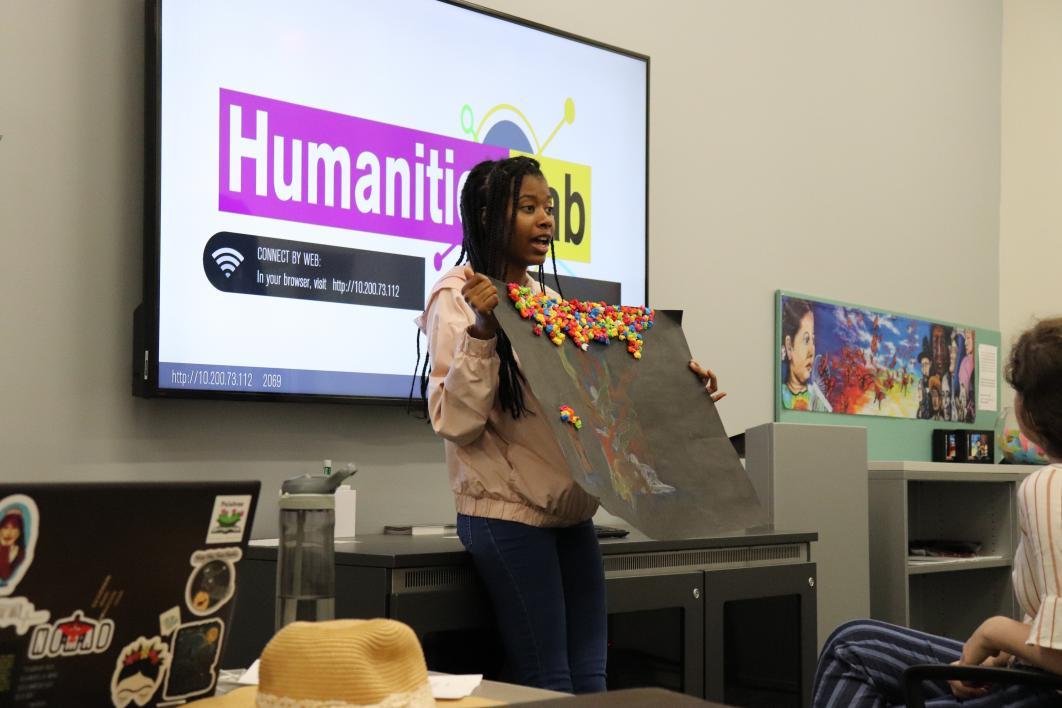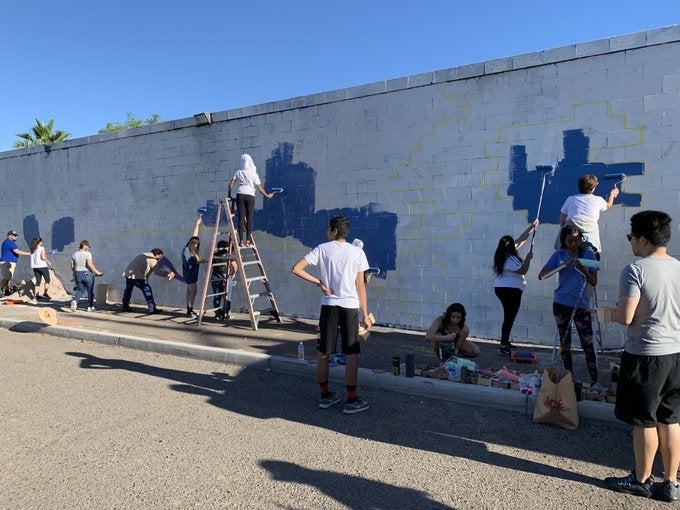Out of the classroom and into the community

The Facing Immigration II class in front of the mural-in-progress they helped design and paint with artist Hugo Medina. Photo courtesy of Alexander Aviña
Some students major in the humanities; others take a humanities class just to check off a general credit. No matter how you end up in a humanities class, you can expect to be learning skills such as critical thinking, clear communication, complex problem-solving and how to apply knowledge in real-world settings. That last one can be hard to learn within a classroom setting, but the Humanities Lab at Arizona State University is developing classes to get students into the community to apply their lessons to the world around them.
A class that gained a lot of discussion this spring was the Facing Immigration II course. The class was co-taught by Alexander Aviña, associate professor of 20th-century Mexican history in the School of Historical, Philosophical and Religious Studies and Emir Estrada, assistant professor of sociocultural anthropology in the School of Human Evolution and Social Change.
“The goal of this class was to get students out of the classroom,” said Estrada. “How do we get them engaged in the community? How do we get them to ask questions versus just reading articles and repeating the information?”
The professors decided they wanted art to be one of the teaching methods included in this course. During the semester, Estrada taught the class the art form of repujado, an embossing method that creates images and designs out of foil, metal, paper or other materials.
She has been practicing repujado for a long time, initially making items as gifts until she started getting paid to create the art. After she and her mother immigrated to America, she used the money from her art to help pay for books and to keep her from getting a third job in college.
“I’ve been doing this art form for about 20 years,” said Estrada. “When I asked if I could use any teaching method I wanted, they were open to the possibility of using that form. So I taught my students how to do repujado and then I kind of instilled that idea of, ‘This is what I do with it and it’s a part of my immigration story.’”
The students in the class were encouraged to think of their own immigration story and to use art as a way to tell those stories with the greater community.
After completing their repujado projects, the students took a cardboard painting workshop with artist Ramiro Gomez who spoke a few days later at their repujado art exhibit at the Phoenix Center for the Arts.
The repujado artwork the class did hangs in a gallery in the Phoenix Center for the Arts.
The students in the class decided to sell their artwork at the exhibit and wanted to donate the money to help those trying to immigrate to the United States. Ultimately they decided to donate to an organization called Aliento, meaning "breath" in Spanish.
Aliento uses art to promote community healing for those who are lacking an immigration status. It was founded in 2016 by ASU alumna Reyna Montoya, who holds bachelor's degrees in political science and transborder studies and a dance minor from ASU. She is proud to be able to help others who have experienced similar circumstances.
“I like being able to bring other artists to collaborate and think about the creative process and how the creative process in art can be a tool for us to process healing and to restore agency,” said Montoya. “As people who have been marginalized or have been oppressed, it’s like we have agency, we have power we are so much more than sad stories. So how can we use art to express our stories in our own way?”
The art exhibit was not the final project for the students, though. They worked with other forms of art to relay stories of immigration and family while also learning through lectures and from conversations they were bringing into their community.
One of the biggest assignments the students took on was a community mural project with artist Hugo Medina. Medina is a Bolivian-born artist who immigrated to New York when he was a child. His paintings and community work have carried him across the country for new projects. He has been commissioned to paint murals in Phoenix before, and the class wanted to work with him for their project.
Anthropology PhD candidate and student in the course, Brittany Romanello, spearheaded the effort to apply for a grant from the Osher Life Long Learning Institute to fund the mural project.
Students from the Humanities Lab class and students from OLLI met with Hugo Medina for a storytelling event. Everyone exchanged stories of their own backgrounds and helped design a mural together.
“It was a beautiful example of what can be accomplished when people of many backgrounds and viewpoints choose to unite in a common goal,” said Romanello. “We've been fooled by many systems of power into believing that our individual voices and desires for change don't matter. They absolutely do. We can resist together by any means necessary. If it's your art, if it's your music, if it's your speech or your hugs or the way you do math — it's all valid. It's all needed, too. I think we all felt that deeply in those moments at the storytelling event.”
By the end of the semester, students had been pushed out of their comfort zones, but learned how to combine education and engagement.
“I wasn't prepared for what a creative and emotional experience the class would be, and how it would impact me personally and academically,” said Romanello. “We need that humanization of others, we need that softness and vulnerability with each other that influences change on a real, physical level. I'm really proud and honored I've been a part of it.”
Alicia Godinez, an undergraduate student studying Spanish in the School of International Letters and Cultures, had taken the Facing Immigration I course and wanted to learn more about how to help her community. She was blown away by how much she and her classmates were able to accomplish during the semester.
“It started in a small classroom, a repujado art event and it turned to another project where we paint a mural, but all with one purpose; bring community together,” said Godinez. “It’s a vision that can go far beyond. Art was a bridge to help the community to be unified, to be humanified and to realize you are not alone.”
Students not only left the class with experiences they will remember for a long time, but with tangible skills and practices they can include in future job applications as well. They earned grants, executed projects and public events, gained experience in controlling a social media account and learned how to communicate their research to multiple news outlets.
“It is an amazing class,” said Godinez. “This class shows you the real world in many areas. It gives you the push to learn new things or new experiences you can add to your resume. I will take this class just for the fact you are seen as a person not just another student.”
Although the Facing Immigration courses will not be offered next semester through Humanities Lab, the lab is offering other interdisciplinary courses that will take students into an experimental space to investigate grand social challenges.
More Arts, humanities and education

Upcoming exhibition brings experimental art and more to the West Valley campus
Ask Tra Bouscaren how he got into art and his answer is simple.“Art saved my life when I was 19,” he says. “I was in a…

ASU professor, alum named Yamaha '40 Under 40' outstanding music educators
A music career conference that connects college students with such industry leaders as Timbaland. A K–12 program that…

ASU's Poitier Film School to host master classes, screening series with visionary filmmakers
Rodrigo Reyes, the acclaimed Mexican American filmmaker and Guggenheim Fellow whose 2022 documentary “Sansón and Me” won the Best…





